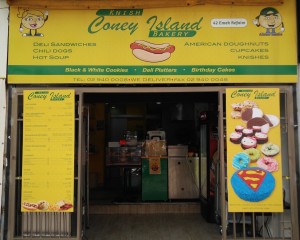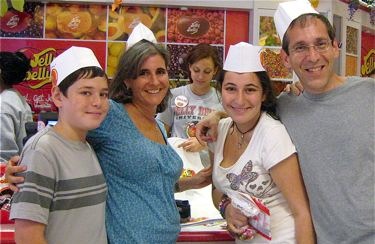 When the German Colony branch of Jerusalem’s Pe’er Bakery closed down last year after 43 years of operation, fans of its signature sweet whole wheat challah let out a collective kvetch: where would we go for challah now on Fridays?
When the German Colony branch of Jerusalem’s Pe’er Bakery closed down last year after 43 years of operation, fans of its signature sweet whole wheat challah let out a collective kvetch: where would we go for challah now on Fridays?
But Pe’er’s challah is back in the neighborhood, albeit at another establishment – the Coney Island Knish Bakery on Emek Refaim Street. The story of how a beloved taste was resurrected is all the more remarkable given that the man behind Coney Island’s product mix, food consultant Avi Pinchuck, has celiac disease and has tasted neither his new creation nor the original Pe’er challot.
There’s a personal twist to this story too. As a die hard Pe’er fan, I have served in an unofficial (and unpaid) role as a Coney Island taste tester, reporting back to Avi on Saturday nights as he’s tinkered with the recipe to get that old Pe’er taste just right.
I may also have had just a little bit to do with getting the ball rolling in the first place. As I wrote last year in this column (Ch’aliyah – immigrating because the bread is better – May 21, 2015), when Pe’er’s proprietors, Moshe and Shoshana Sharabi, decided to retire from the painstaking, early rising, messy and hardscrabble business, I was sent into an existential tizzy and began a frantic search to replace not only the challah I loved, but one of the pillars upon which our very aliyah was based.
The closest I could find to what Pe’er had been producing was at Coney Island. While chatting with Avi, I learned that he was buying the challah from another bakery but looking to make his own.
“Wouldn’t it be great if you could get the old Pe’er recipe?” I casually suggested. “I’m sure many of Pe’er’s old customers would come running!”
It turns out, I wasn’t the first person to approach Avi with the idea, and it wasn’t long until the challot at Coney Island looked different.
“We did it,” Avi said proudly, as I gave the strangely familiar loaf the once over. “We got the recipe. You’ve got to tell me what you think!”
I took home a couple white and a sweet whole wheat challah for that Shabbat. After months of being Pe’er-less, we said the motzei over the bread with extra anticipation, tore the challah into pieces and distributed it around the table. I waited for the verdict.
“Interesting,” said one child. “It’s good,” said another.
“Yum,” said my wife Jody. “But, well, I don’t want to burst your bubble, but it’s not Pe’er.”
When I reported our family findings to Avi on Motzei Shabbat, as I’d promised, I was initiated into the little known world of bread baking back room deals.
Most small bakeries in Israel, I soon discovered, don’t actually make their own bread. They buy it from a middleman whose expertise it is to make just dough.
These dough men might have 20 different recipes going at once, but it’s not a one-to-one transaction: a dough middleman can sell the exact same recipe to hundreds of different bakeries around the country, who all prepare it slightly differently when they get it to their shop. “That’s why so much of the stuff you find in Israeli bakeries looks the same; they’re all getting it from the same places,” Avi explained. “All they’re doing is brushing on some egg, putting on poppy seeds and calling it their own. Especially for smaller bakeries, you don’t need to have a trained baker on staff.”
Moshe and Shoshana of Pe’er contracted Belissimo, a dough middleman in Rishon Letzion. Moshe used to make his own dough at Pe’er’s German Colony headquarters, but with that shut down, they were looking for a way to keep their recipe alive in order to supply dough to the one remaining Pe’er outlet in the Mahane Yehuda market, run by the Sharabi’s son. Coney Island was welcome to piggyback on the recipe, as was anyone else, Moshe told Avi; he was putting it into the public domain, a kind of open source approach to challah.
So why didn’t Coney Island’s Pe’er-formula challah taste the same as the old Pe’er? “Challah making is more of a science than an art,” Avi explained. Everything has to be kept exactly the same – not just the ingredients, but a whole host of factors such as humidity, altitude and different oven types. All of these impact the taste.
Avi ought to know. Before making aliyah with his family ten years, he worked for decades in the food business, both running his own food plant in Chicago, which sold to big customers like Heinz, and more recently as a food consultant. (He helped an Irish popcorn manufacturer solve a problem with shelf life, for example.)
The challah from a dough middleman like Belissimo is delivered frozen. It then must be thawed and “proofed” – that’s where the dough is allowed to rise – before it’s finally baked. Subtle differences can make big changes in taste. Pe’er’s original dough was never frozen. Moreover, it was proofed and baked in Jerusalem, while Coney Island’s facility is in Beit Shemesh, where it’s warmer and much closer to sea level.
There’s another reason why the Pe’er challah recipe at Coney Island didn’t taste quite the same: it may have been “dumbed down.”
“Israelis don’t love super sweet challah,” Moshe Sharabi told my wife Jody when she bumped into him entirely by accident at the Pe’er branch in Mahane Yehuda which caters more to Sabras than in the heavily Anglo German Colony. The recipe he gave to Belissimo, as a result, might have had a slightly less sugary balance.
Avi understands. “Americans love their sweet, almost raw challot,” he said. “Israelis will throw something like that in the garbage. They’re used to challah being a bit dry. Supermarket challah uses the cheapest ingredients on the planet – just water and flour. No sugar, no eggs.” If you’re on a budget and you’re trying to feed a big family, paying NIS 8 a loaf is half the price of a challah at Pe’er or Coney Island.
Avi conceived of Coney Island as an authentic New York bakery experience, one with not just challah, but knishes, cupcakes and black and white cookies. A big part of the business is making oversized themed birthday and bnei mitzvah cakes.
Last year, they converted the Emek Refaim branch to serve American-style kosher meat products: chili dogs, double stuffed pastrami on rye. (The desserts are all parve.) A second branch opened downtown, on Jaffa Street. They are distributing to several small supermarkets in the Gush Etzion region and looking into Ra’anana.
Avi is still tinkering with the mechanics of his challah: the proofing and thawing at different times of the year all make a difference, even if the dough remains the same. That’s not easy, of course, if you can’t taste what you’re baking.
“I was diagnosed with celiac disease ten years ago,” Avi said. “I was sick for about 7 years before that. The doctors couldn’t figure out. Back then, they were hardly any gluten free products available. The awareness now is a thousand fold.”
In a sad irony for a family in the food business, all of his kids have the disease too.
Coney Island sells a gluten-free challah made out of oats. I tried it – it’s not bad, but it’s the classic Pe’er experience that I’m looking for. Coney Island’s white and whole wheat challot are close but not quite there yet.
I guess I’ve still got a little more time to serve in my role as weekly taste tester.
I first told my taste testing tale at The Jerusalem Post.

